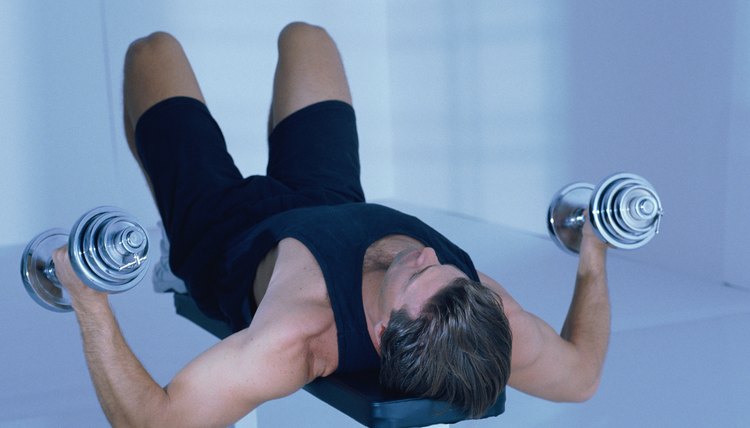Pectoral Exercises for the Sternocostal Head

The largest muscle of the chest is the pectoralis major. More specifically, it is the sternocostal head of the pec major. This muscle is between the upper and lower pec major muscles, which are known as the clavicular and abdominal heads, respectively. To develop the sternocostal head, you must train with resistance to overload and stimulate the muscle fibers to grow. It takes several weeks or months to make gains in muscle mass, so it is vital you are consistent with your training.
Anatomical Overview
The sternocostal head of the pec major, also called the middle chest, originates at the second to sixth ribs. The muscle spans across the thorax and inserts at the humerus, or arm bone. There are two primary functions of the sternocostal head: shoulder flexion in the horizontal direction and shoulder adduction in the horizontal direction. Both anatomical movements can be simply translated to bringing your arm bone toward the middle of your chest. Each time you hug someone, you are activating your sternocostal head as you move your arms inward and across your chest.
Basic Exercises
The most basic exercise you can do for the sternocostal head is the pushup. This movement is mostly recommended for beginners, as you are only using your body weight. Advanced trainees may not benefit as much from doing body-weight pushups and should use added resistance if they chose to do the exercise.
Intermediate/Advanced Exercises
The best exercises to build the mass of the sternocostal part of the pec major are the bench press and the pec fly. You can perform both of these exercises using free weight equipment. To primarily work the sternocostal head during execution of these movements, it is imperative you use a flat bench. This zero-degree angle minimizes the involvement of the other pec major muscles.
Workout
During your chest workouts, do no more than two exercises for the sternocostal head. For example, you can do the bench press and the pec fly, or the pushup and pec fly. Do two additional exercises, one for your upper pecs and one for your lower pecs. For the upper pecs, do the bench press or fly using an incline bench. For the lower pecs, use a decline bench. Each exercise in your workout should comprise of three sets of eight to 12 reps to sufficiently stimulate your muscles, causing them to grow in the long term with repeated workouts.
References
Writer Bio
Richard Choueiri is a fitness and nutrition expert and the author of "The Human Statue Workout." He began writing professionally in 2007 and his work has been featured in Bodybuilding.com and "Physique Magazine." Choueiri studied exercise science and nutritional science at Rutgers University. He holds an American College of Sports Medicine CPT, and a National Exercise and Sports Trainers Association CMMACC.
